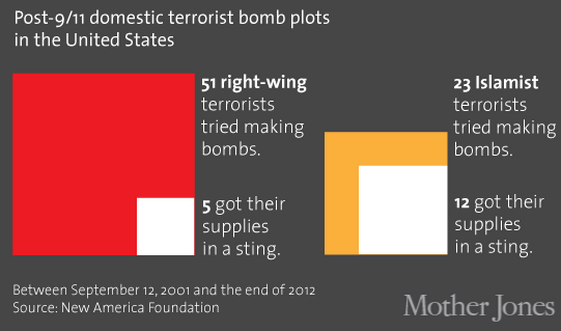
Photo courtesy of Oklahomacitybombing.com
Over the past decade, as public angst has been stewing over the threat of foreign, Islamist-born terrorist activity, right-wing domestic extremists have been responsible for the vast majority of attacks on the American public, counting 65 attacks since 9/11, compared to 24 by jihadists, according to the Global Terrorism Database held by the Start Center at the University of Maryland.[ref]Charles Kurzman and David Schanzer. “The Growing Right-Wing Terror Threat.” The New York Times. June 16, 2015.[/ref] Other estimates, depending on how one defines right-wing extremism, have reached as many as 337 annual attacks in the decade after 9/11. Politically conservative extremists, touting viscerally-held ideals like individual sovereignty from the law, unbridled gun rights, white supremacy, and anti-immigrant, generally racist sentiments have been waging a largely unanswered war against the U.S. and its people since the mid-1990s. Daryl Johnson, a former domestic terrorism specialist at the Dept. of Homeland Security, and Michael German, a former FBI agent and now a national security expert at the Brennan Center for Justice, explain that “federal counterterrorism programs since 9/11 have focused overwhelmingly on the perceived threat from Islamic extremism,” despite agreement among law enforcement agencies across the country that home-grown, antigovernment right-wing extremists pose the most significant threat to the American public.[ref]Jaeh Lee, Brandon Ellington Patterson, and Gabrielle Canon. “The Rise of Violent Right-Wing Extremism, Explained.” Mother Jones. June 30, 2015.[/ref]
Attacks like the ones in Oklahoma City in 1995, at the Atlanta Olympics in 1996 and in a Charleston, SC church, just to name a few, are often carried out by right-wing extremists with stunningly easy access to weapons and ammunition, and so the vendetta lies in the disconnect between the government’s antiterrorism programs, revolving around “impeding the radicalization of violent jihadists,”[ref]Ibid[/ref] and the fact that most terrorists in the US are white extremists who thrive on our dismal gun control. While Islamist-born threats undoubtedly exist and call for action, law enforcement officials agree that the growing threat of right-wing extremism—particularly after the economic collapse and the election of the first African American president—requires a more nuanced approach to combatting terrorism that incorporates stringent gun control measures and more proactive mental health programs.
Part of the problem with combatting this threat is the absence of a clear definition of “far-right” and “right-wing” extremists. The terms “loosely encompass individuals or groups associated with white supremacist, antigovernment, sovereign citizens, patriot, militia, or other ideologies that target specific religious, ethnic, or other minority groups.”[ref]Ibid[/ref] Obviously, then, a related issue is the sheer volume of the threat, with some estimating that there are 300,000 people involved in some way with sovereign citizen extremism, explains Mark Potok, a senior fellow at the Southern Poverty Law Center.[ref]Wes Bruer and Evan Perez. “DHS intelligence report warns of domestic right-wing terror threat.” CNN. February 20, 2015.[/ref] Where do we draw the line between our beloved free speech and extremist propaganda? Michael German submits that, in order to keep closer tabs over right-wing extremists, the study of these groups must focus more on their methodologies and recruitment, as opposed to their ideologies.[ref]Lee, Patterson and Canon, 2015.[/ref] Otherwise, discerning between violent language and actual threats is next to impossible.
Perhaps the biggest obstacle to effectively targeting dangerous groups or lone wolfs with far-right extremist views, as opposed to Islamic extremists, is that groups with very similar—though not violent—interests are represented in Congress. Tea Party Republicans’ antigovernment beliefs, for instance, are reminiscent of many violent right-wing extremists’, even though their actions rarely take dangerous turns; conversely, there are seldom any Muslim congressmen and women. Indeed, when two right-wing extremists executed a couple of police officers at a restaurant and then laid the Gadsden flag over their bodies, the phrase, “Don’t tread on me,” invoked so often by the Tea Party, took on a menacing connotation. So while it is politically safer for the federal government to focus on Islamic terror threats, the disconnect remains between our antiterrorism programs and the most immediate terror threats facing the nation.
The Department of Homeland Security circulated a domestic terrorism assessment in 2009 and earlier this year, the main point of which has remained relatively unchanged: the social progress being made in the United States—i.e. the election of a black president and the tremendous gains made by the LGBTQ movement—in concert with the economic collapse of 2008, has significantly increased recruitment rates by violent far-right extremist groups founded on white supremacist and sovereign citizen ideals.[ref]United State Department of Homeland Security. US Dept of Homeland Security Assessment: (U//FOUO) Rightwing Extremism: Current Economic and Political Climate Fueling Resurgence in Radicalization and Recruitment. 2009.[/ref] Ironically, it seems as though the paranoia-fueled violence of many extremists has only served to increase the vigilance of the FBI and the Dept. of Homeland Security. Nationwide, the public largely still considers jihadists to be the most dire terror threat, and indeed they do remain a threat, but until meaningful gun control legislation is made across the United States, the biggest peril facing the American people will go unaddressed.
Take Action:
Again, while jihadist terror plots continue to be foiled, the nature of the gravest terror threats facing the nation has morphed—particularly since 2008—and so the federal government’s response must also evolve. Preventing hate-filled citizens and criminals from possessing firearms is now the most reasonable way to prevent the majority of terror plots. This must first sink into the public consciousness through strategic policy campaigns and extensive research reports, all work being done by the Coalition to Stop Gun Violence, an umbrella group of 48 organizations dedicated to the prevention of gun violence across the United States. Visit this site to join the effort and donate.





